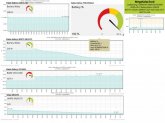svetz
Works in theory! Practice? That's something else
The goal is to only to determine if the panels have gotten soiled to the point they need cleaning (individual panel issues would be detected by the method in #17). So, sensor accuracy isn't as important as sensor consistency.
As long as the sensor's data is consistently relative to the panel's output, then it should be able to be used to determine if the overall output has dropped below a desirable threshold. At least that's the theory. To test it with the wunderground data I'll need to collect a lot of data and see how much variance there is.
Of course, if the sensor is getting soiled at the same rate as the panels then it's not going to do much good. @jasonhc73 has had his weather station for a while now, perhaps he can comment on that? I'm guessing if it has a bubble top like a Pyranometer it'll probably stay relatively clean.
As long as the sensor's data is consistently relative to the panel's output, then it should be able to be used to determine if the overall output has dropped below a desirable threshold. At least that's the theory. To test it with the wunderground data I'll need to collect a lot of data and see how much variance there is.
Of course, if the sensor is getting soiled at the same rate as the panels then it's not going to do much good. @jasonhc73 has had his weather station for a while now, perhaps he can comment on that? I'm guessing if it has a bubble top like a Pyranometer it'll probably stay relatively clean.



